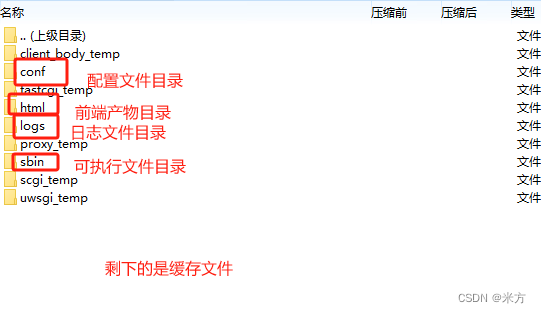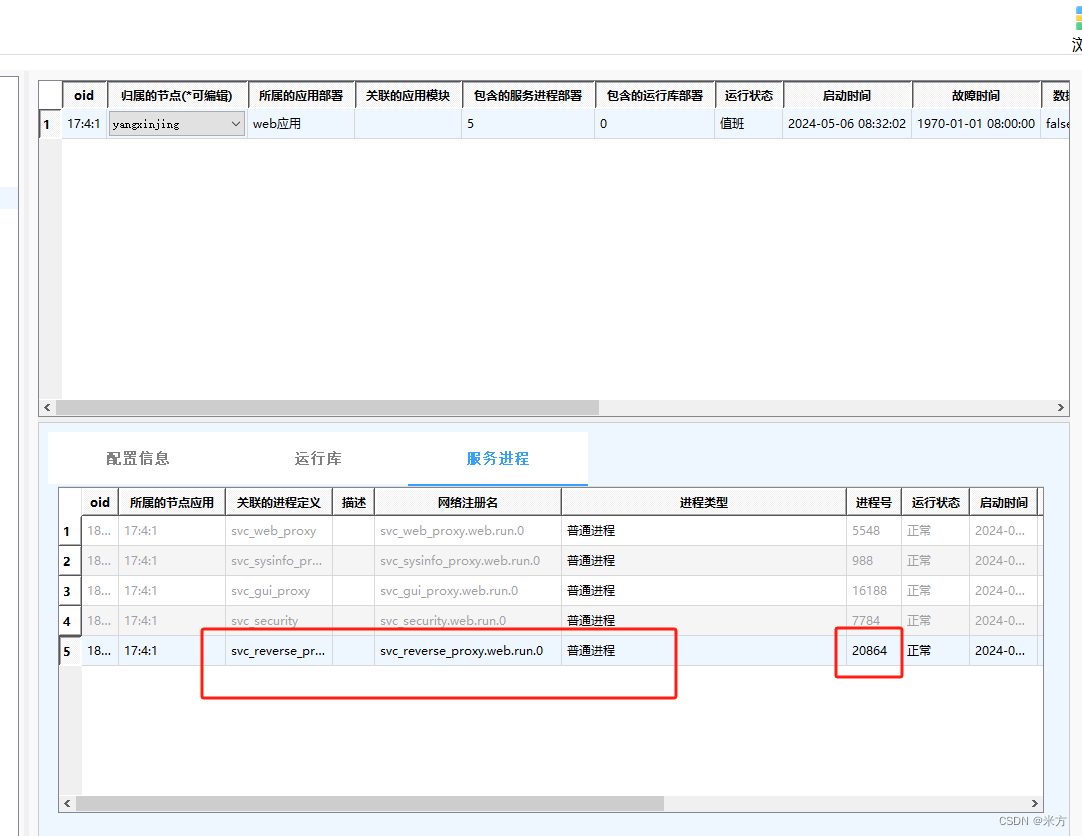项目里面有一个需求,就是需要用让nginx进程提供给系统管理一个start,stop和getPid方法,这样系统管理可以自动拉起来nginx,达到自动部署的目的。离线部署同样适用
这样一来,我就需要提供windows版本linux不同版本的nginx源码包,windows版本的好办,就直接从官网下载的,我下载的是nginx1.24.0的稳定版本的,linux版本的就需要自己编译源码包了,因为wget下载的nginx首先产物目录就很不一样,我需要就是跟windows差不多的目录结构,便于我写nginx.conf配置文件
window的产物目录如下

linux产物目录如下

linux的这个产物只需要编译一次,后面部署就直接拷贝这个就可以了,编译的过程如下:
官网下载nginx源码,新建一个文件夹叫Nginx
进入到源码目录
./configure --prefix=新建的产物目录地址
make -j12
make install 可能中间需要装 pcre库,wget 下载一下好了。
pcre是因为我的nginx配置需要用到正则,就是html下面有不同文件夹,每个文件夹是一个项目,部署的时候有多少个文件夹部署多少个项目。
这个过程比较曲折,首先nginx没有地方写日志是不会启动成功的,所以配置文件需要指定日志的生成位置,还有配置文件的启动位置,pid等
贴一份windows的配置文件:
worker_processes 1;
error_log D:/code/system/run/nginx/logs/error.log error;
pid D:/code/system/run/nginx/logs/nginx.pid;
events {
worker_connections 1024;
}
http {
include mime.types;
default_type application/octet-stream;
sendfile on;
keepalive_timeout 65;
access_log D:/code/system/run/nginx/logs/access.log;
map $_FilePath $_FilePathForUse {
"" "index.html";
"/" "index.html";
default $filePathFromRemote;
}
client_body_temp_path D:/code/system/run/nginx/temp/client_temp;
proxy_temp_path D:/code/system/run/nginx/temp/proxy_temp;
fastcgi_temp_path D:/code/system/run/nginx/temp/fastcgi_temp;
uwsgi_temp_path D:/code/system/run/nginx/temp/uwsgi_temp;
scgi_temp_path D:/code/system/run/nginx/temp/scgi_temp;
server {
listen 8090;
location /{
gzip on;
gzip_static on;
root D:/code/system/run/nginx/html/;
add_header X-URI-Part1 $1;
add_header X-URI-Part2 $2;
add_header 'Access-Control-Allow-Origin' '*';
add_header 'Access-Control-Allow-Credentials' 'true';
set $module $1;
set $filePathFromRemote $2;
set $_FilePath "$filePathFromRemote";
}
error_page 500 502 503 504 /50x.html;
}
server {
listen 9000;
location / {
root D:/code/system/run;
autoindex on;
add_header Access-Control-Allow-Origin *;
add_header Access-Control-Allow-Headers X-Requested-With;
add_header Access-Control-Allow-Methods GET,POST,PUT,DELETE,OPTIONS;
}
}
}
两个server是因为还用到了nginx做文件服务
linux版本的配置文件:
worker_processes 1;
error_log ${ROOT_DIR}/run/nginx/logs/error.log error;
pid ${ROOT_DIR}/run/nginx/logs/nginx.pid;
events {
worker_connections 1024;
}
http {
include mime.types;
default_type application/octet-stream;
sendfile on;
keepalive_timeout 65;
access_log ${ROOT_DIR}/run/nginx/logs/access.log;
map $_FilePath $_FilePathForUse {
"" "index.html";
"/" "index.html";
default $filePathFromRemote;
}
client_body_temp_path ${ROOT_DIR}/run/nginx/client_temp;
proxy_temp_path ${ROOT_DIR}/run/nginx/proxy_temp;
fastcgi_temp_path ${ROOT_DIR}/run/nginx/fastcgi_temp;
uwsgi_temp_path ${ROOT_DIR}/run/nginx/uwsgi_temp;
scgi_temp_path ${ROOT_DIR}/run/nginx/scgi_temp;
server {
listen 8090;
server_name localhost;
location ~ ^/([^/]+)(/?.*)$ {
root ${ROOT_DIR}/run/nginx/html/;
add_header 'Access-Control-Allow-Origin' '*';
add_header 'Access-Control-Allow-Credentials' 'true';
set $module $1;
set $filePathFromRemote $2;
set $_FilePath "$filePathFromRemote";
}
error_page 500 502 503 504 /50x.html;
location = /50x.html {
root ${ROOT_DIR}/run/nginx/html;
}
}
server {
listen 9000;
server_name localhost;
location / {
root ${ROOT_DIR}/run;
autoindex on;
add_header Access-Control-Allow-Origin *;
add_header Access-Control-Allow-Headers X-Requested-With;
add_header Access-Control-Allow-Methods GET,POST,PUT,DELETE,OPTIONS;
}
}
}这两个配置文件的生成是通过脚本自动写入的,用到了各自系统的环境变量
下面就是启动程序了
start方法
#ifdef _WIN64
cmd = fmt::format("{}/nginx/nginx -c {}/nginx/conf/nginx.conf -e {}/nginx/logs/error.log",
根目录,
根目录);
#endif
#ifdef __linux__
cmd = fmt::format("{}/nginx/sbin/nginx -c {}/nginx/conf/nginx.conf -e {}/nginx/logs/error.log",根目录,根目录,根目录);
#endif
大概就是通过命令行启动nginx进程,涉及到一些公司里面封装的底层方法,就不方便写了。。
stop方法同理
getPid方法比较复杂,nginx每次启动成功都会往nginx.pid文件写入一个进程号,需要把文件读出来然后返回出去,而且需要自己判断进程是不是存活,不能返回一个没有启动的进程出去。
启动成功之后浏览器输入当前机器的ip地址:8090就能访问到内容
系统管理界面可以管理nginx的启停
